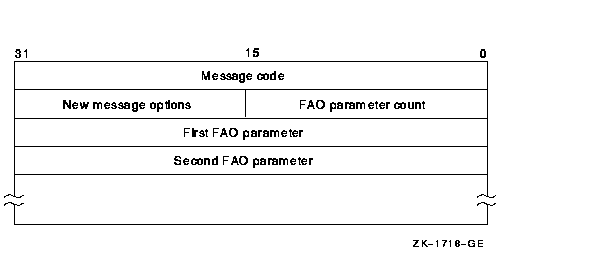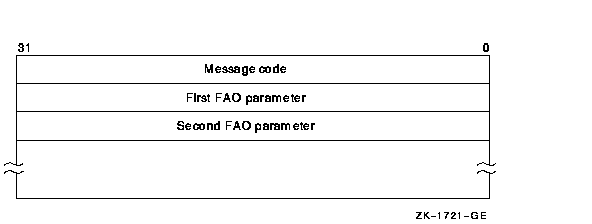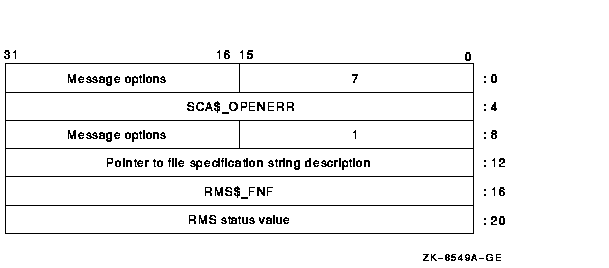Software > OpenVMS Systems > Documentation > 84final > 4527 HP OpenVMS Systems Documentation |
HP OpenVMS System Services Reference Manual
For item codes that describe bit masks, such as privilege masks and status words, this flag controls how the pattern bit mask specified by the item descriptor is compared with that in the process. By default, the bit masks are compared for equality. The PSCAN$M_BIT_ALL flag is used only with bit masks. PSCAN$M_BIT_ANYIf the PSCAN$M_BIT_ANY flag is used, a match occurs if any bit in the pattern mask is also set in the process mask.For item codes that describe bit masks, such as privilege masks and status words, this flag controls how the pattern bit mask specified by the item descriptor is compared with that in the process. By default, the bit masks are compared for equality. The PSCAN$M_BIT_ANY flag is used only with bit masks. PSCAN$M_CASE_BLINDWhen you specify PSCAN$M_CASE_BLIND to compare the character string specified by the item descriptor with the character string value from the process, $PROCESS_SCAN does not distinguish between uppercase and lowercase letters.The PSCAN$M_CASE_BLIND flag is used only with character-string item codes. The PSCAN$M_CASE_BLIND flag can be specified with either the PSCAN$M_PREFIX_MATCH flag or the PSCAN$M_WILDCARD flag. PSCAN$M_EQLWhen you specify PSCAN$M_EQL, $PROCESS_SCAN compares the value specified by the item descriptor with the value from the process to see if there is an exact match.PSCAN$M_EQL and PSCAN$M_NEQ are used with bit masks, character strings, and integers to control how the item is interpreted. Only one of the flags can be specified; if more than one of these flags is used, the SS$_BADPARAM error is returned. If you want to specify that bits not set in the pattern mask must not be set in the process mask, use PSCAN$M_EQL. PSCAN$M_GEQWhen you specify PSCAN$M_GEQ, $PROCESS_SCAN selects a process if the value from the process is greater than or equal to the value specified by the item descriptor.PSCAN$M_GEQ, PSCAN$M_GTR, PSCAN$M_LEQ, and PSCAN$M_LSS are used with integer item codes only. Only one of these four flags can be specified; if more than one of these flags is used, the SS$_BADPARAM error is returned. PSCAN$M_GTRWhen you specify PSCAN$M_GTR, $PROCESS_SCAN selects a process if the value from the process is greater than the value specified by the item descriptor.PSCAN$M_GEQ, PSCAN$M_GTR, PSCAN$M_LEQ, and PSCAN$M_LSS are used with integer item codes only. Only one of these four flags can be specified; if more than one of these flags is used, the SS$_BADPARAM error is returned. PSCAN$M_LEQWhen you specify PSCAN$M_LEQ, $PROCESS_SCAN selects a process if the value from the process is less than or equal to the value specified by the item descriptor.PSCAN$M_GEQ, PSCAN$M_GTR, PSCAN$M_LEQ, and PSCAN$M_LSS are used with integer item codes only. Only one of these four flags can be specified; if more than one of these flags is used, the SS$_BADPARAM error is returned. PSCAN$M_LSSWhen you specify PSCAN$M_LSS, $PROCESS_SCAN selects a process if the value from the process is less than the value specified by the item descriptor.PSCAN$M_GEQ, PSCAN$M_GTR, PSCAN$M_LEQ, and PSCAN$M_LSS are used with integer item codes only. Only one of these four flags can be specified; if more than one of these flags is used, the SS$_BADPARAM error is returned. PSCAN$M_NEQWhen you specify PSCAN$M_NEQ, $PROCESS_SCAN selects a process if the value from the process is not equal to the value specified by the item descriptor.PSCAN$M_EQL and PSCAN$M_NEQ are used with bit masks, character strings, and integers to control how the item is interpreted. Only one of the flags can be specified; if more than one of these flags is used, the SS$_BADPARAM error is returned. PSCAN$M_ORWhen you specify PSCAN$M_OR, $PROCESS_SCAN selects processes whose values match the current item descriptor or the next item descriptor. The next item descriptor must have the same item code as the item descriptor with the PSCAN$M_OR flag. Multiple items are chained together; all except the last item descriptor must have the PSCAN$M_OR flag.The PSCAN$M_OR flag can be specified with any other flag and can be used with bit masks, character strings, and integers. If the PSCAN$M_OR flag is used between different item codes, or if it is missing between identical item codes, the SS$_BADPARAM error is returned. PSCAN$M_PREFIX_MATCHWhen you specify PSCAN$M_PREFIX_MATCH, $PROCESS_SCAN compares the character string specified in the item descriptor to the leading characters of the requested process value.For example, to find all process names that start with the letters AB, use the string AB with the PSCAN$M_PREFIX_MATCH flag. If you do not specify the PSCAN$M_PREFIX_MATCH flag, the search looks for a process with the 2-character process name AB. The PSCAN$M_PREFIX_MATCH flag also allows either the PSCAN$M_EQL or the PSCAN$M_NEQ flag to be specified. If you specify PSCAN$M_NEQ, the service matches those names that do not begin with the specified character string. The PSCAN$M_PREFIX_MATCH flag is used only with character string item codes. The PSCAN$M_PREFIX_MATCH flag cannot be specified with the PSCAN$M_WILDCARD flag; if both of these flags are used, the SS$_BADPARAM error is returned. PSCAN$M_WILDCARDWhen you specify PSCAN$M_WILDCARD, the character string specified by the item descriptor is assumed to be a wildcard pattern. Acceptable wildcard characters are the asterisk (*), which allows the match to substitute any number of character in place of the asterisk, and the percent sign (%), which allows the match to substitute any one character in place of the percent sign. For example, if you want to search for all process names that begin with the letter A and end with the string ER, use the string A*ER with the PSCAN$M_WILDCARD flag. If the PSCAN$M_WILDCARD flag is not specified, the search looks for the 4-character process name A*ER.The PSCAN$M_WILDCARD is used only with character string item codes. The PSCAN$M_WILDCARD flag cannot be specified with the PSCAN$M_PREFIX_MATCH flag; if both of these flags are used, the SS$_BADPARAM error is returned. The PSCAN$M_NEQ flag can be used with PSCAN$M_WILDCARD to exclude values during a wildcard search. The following restrictions apply to the flags above:
DescriptionThe Process Scan system service creates and initializes a process context that is used by $GETJPI to scan processes on the local system or across the nodes in an OpenVMS Cluster system. An item list is used to specify selection criteria to obtain information about specific processes, for example, all processes owned by one user or all batch processes. Condition Values Returned
$PURGWS
Removes a specified range of pages from the current working set of the calling process to make room for pages required by a new program segment. FormatSYS$PURGWS inadr C Prototypeint sys$purgws (struct _va_range *inadr); Argument
DescriptionThe Purge Working Set service removes a specified range of pages from the current working set of the calling process to make room for pages required by a new program segment; however, the Adjust Working Set Limit ($ADJWSL) service is the preferred mechanism for controlling a process's use of physical memory resources. Condition Values Returned
$PURGE_WS (Alpha and Integrity servers)
On Alpha and Integrity server systems, removes a specified range of pages from the current working set of the calling process to make room for pages required by a new program segment. FormatSYS$PURGE_WS start_va_64 ,length_64 C Prototypeint sys$purge_ws (void *start_va_64, unsigned __int64 length_64); Arguments
DescriptionThe Purge Working Set service removes a specified range of pages from the current working set of the calling process to make room for pages required by a new program segment; however, the Adjust Working Set Limit ($ADJWSL) service is the preferred mechanism for controlling a process's use of physical memory resources. Condition Values Returned
$PUT
The Put service inserts a record into a file. $PUTMSG
Writes informational and error messages to processes. FormatSYS$PUTMSG msgvec ,[actrtn] ,[facnam] ,[actprm] C Prototypeint sys$putmsg (void *msgvec, int (*actrtn)(__unknown_params), void *facnam, unsigned __int64 actprm); Arguments

The following table describes the message vector fields:
The following table shows the significant bit numbers. Note that the bit numbers shown (0, 1, 2, 3) are the bit positions from the beginning of the word; however, because the word is the second word in the longword, you should add the number 16 to each bit number to specify its exact offset within the longword.
Bits 4 through 15 must be 0. You can override the default setting specified by the default message options field for any or all messages by specifying different options in the new message options field of any subsequent message descriptor. When you specify new message options, the options it specifies become the new default settings for all remaining messages until you specify new message options again. The $PUTMSG service passes the default message options field to the $GETMSG service as the flags argument. If you specify the default message options field as 0, the default message options for the process are used; you can set the process default message options by using the DCL command SET MESSAGE. The Description section shows the format that $PUTMSG uses to write these message components.
The following diagrams depict the message descriptors for each type of message: Message Descriptor for User-Supplied Messages 
Message Descriptor for System Messages 
Message Descriptor for OpenVMS RMS Messages 
Message Descriptor for System Exception Messages 
On Alpha and Integrity server systems, 64-bit message vectors can be used for applications that require them. A 64-bit message vector begins with the same argument count longword as the 32-bit message vector. After the argument count longword is another longword containing the value SS$_SIGNAL64, which signals that a 64-bit message vector follows. Subsequent message vector elements have a layout analogous to 32-bit message vectors but are 64-bits wide. For example, the following diagram depicts the format of a 32-bit message vector: 
The 64-bit version of that same message vector would have the following format: 
The $PUTMSG service accepts either the 32-bit or the 64-bit form of the message vector on Alpha and Integrity server systems. actrtn
User-supplied action routine to be executed during message processing. The actrtn argument is the 32- or 64-bit address (on Alpha and Integrity server systems) of this routine. Note that the first argument passed to the action routine is the address of a character string descriptor pointing to the message text; the parameter specified by actprm is the second. The action routine receives control after a message is formatted but before it is actually written to the user. The completion code in general register R0 from the action routine indicates whether the message should be written. If the low-order bit of R0 is set (1), then the message will be written. If the low-order bit is cleared (0), then the message will not be written. If you do not specify actrtn or specify it as 0 (the default), no action routine executes. Because $PUTMSG writes messages only to SYS$ERROR and SYS$OUTPUT, an action routine is useful when output must be directed to, for example, a file. facnam
Facility prefix to be used in the first or only message written by $PUTMSG. The facnam argument is the 32- or 64-bit address (on Alpha and Integrity server systems) of a character string descriptor pointing to this facility prefix.
|